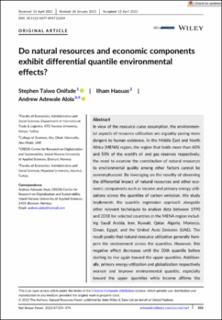Do natural resources and economic components exhibit differential quantile environmental effects?
Peer reviewed, Journal article
Published version
Permanent lenke
https://hdl.handle.net/11250/3093809Utgivelsesdato
2023Metadata
Vis full innførselSamlinger
Sammendrag
In view of the resource curse assumption, the environmen-tal aspects of resource utilization are arguably posing moredangers to human existence. In the Middle East and NorthAfrica (MENA) region, the region that holds more than 60%and 50% of the world's oil and gas reserves respectively,the need to examine the contribution of natural resourcesto environmental quality among other factors cannot beoveremphasized. By leveraging on the novelty of observingthe differential impact of natural resources and other eco-nomic components such as income and primary energy utili-zations across the quantiles of carbon emission, this studyimplements the quantile regression approach alongsideother relevant techniques to analyze data between 1990and 2018 for selected countries in the MENA region includ-ing Saudi Arabia, Iran, Kuwait, Qatar, Algeria, Morocco,Oman, Egypt, and the United Arab Emirates (UAE). Theresult posits that natural resource utilization generally ham-pers the environment across the quantiles. However, thisnegative effect decreases until the 50th quantile beforestarting to rise again toward the upper quantiles. Addition-ally, primary energy utilization and globalization respectivelyworsen and improve environmental quantile, especiallytoward the upper quantiles while income affirms the inverted U-shaped hypothesis across the entire quantiles.Moreover, there is a statistically significant one-way direc-tional causality from natural resources, economic expansion,primary energy use, and globalization to carbon emissionlevels. Hence, the study offers environmentally friendlyresource utilization policies to the MENA economies andother resource-rich states by extension.

